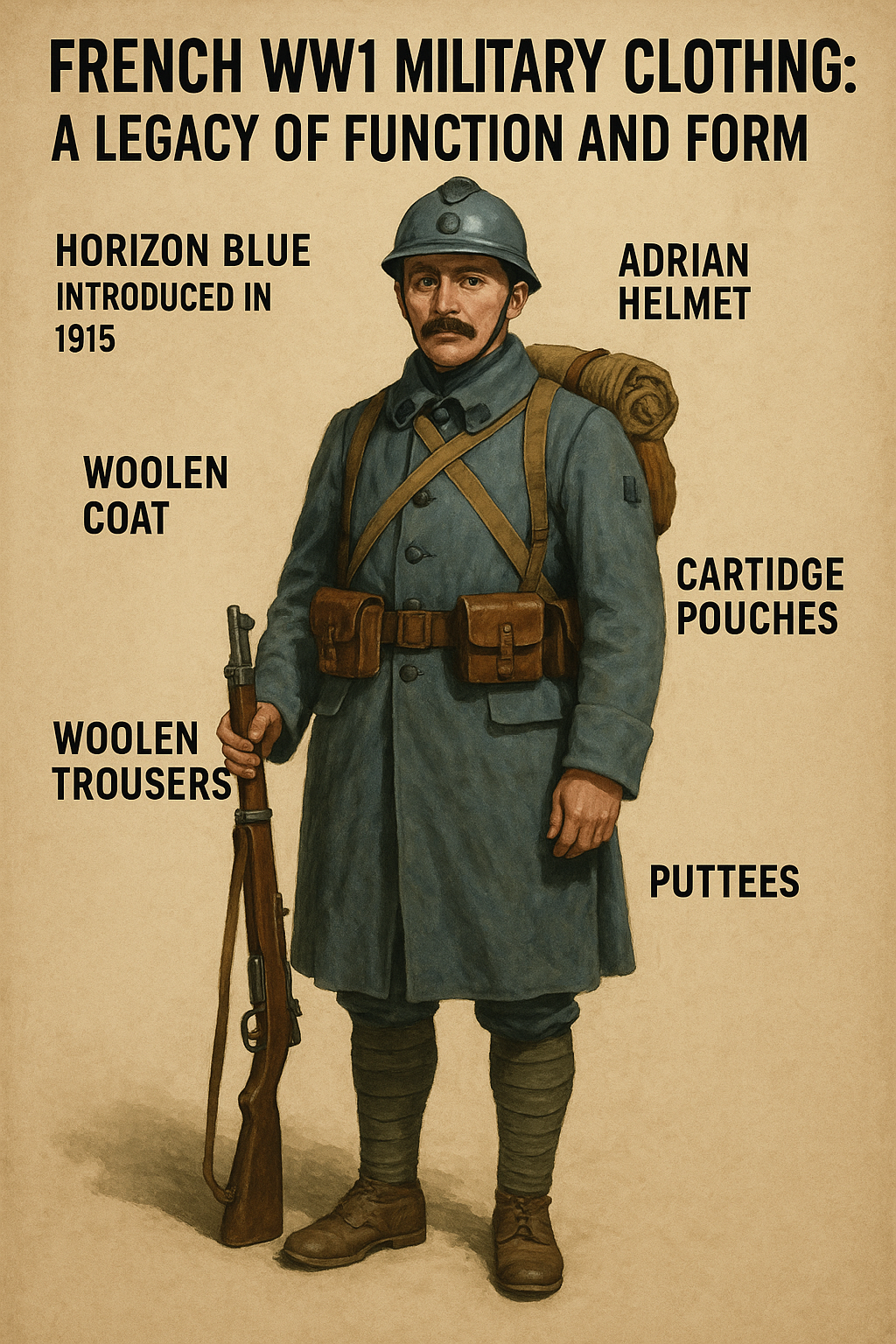
French WW1 Military Clothing – A Legacy of Function and Form
Published on May 23, 2025
Introduction: The Uniform as a Symbol and Tool
Military uniforms serve dual purposes: symbolizing national pride and providing practical protection and utility in combat. French WW1 military clothing exemplifies how uniforms must evolve to meet the demands of war. This era witnessed a pivotal transformation in French military fashion—from ornate pre-war ensembles to gear designed for survival in the brutal trench warfare of World War One.
A Look Back: Pre-War Uniforms and the "Pantalon Rouge"
At the dawn of the 20th century, the French army was instantly recognizable by its flamboyant dress. Soldiers wore dark blue wool tunics and vibrant red trousers—known as the “pantalon rouge.” These uniforms reflected France’s military tradition and the pride of a nation still glowing from past victories.
However, these striking colors, ideal for ceremonial parade grounds, proved to be disastrously visible in the age of long-range rifles and machine guns. When WWI began in 1914, French troops found themselves conspicuous targets, and the need for change was undeniable.
The Turning Point: Horizon Blue and Practicality in the Trenches
By 1915, responding to the grim realities of trench warfare, the French military made one of the most iconic changes in uniform history: they introduced the “horizon blue” uniform.
Why Horizon Blue?
- Color Camouflage: This muted blue-grey color blended more effectively with the foggy, muddy landscapes of European battlefields.
- Mass Production: Unlike the expensive and brightly dyed wool of earlier uniforms, horizon blue cloth was easier and cheaper to produce on a mass scale.
- Standardization: The new uniform came with a redesigned coat (capote), matching trousers, puttees, and the Adrian helmet—France’s first steel combat helmet designed to protect soldiers from shrapnel and debris.
These uniforms marked a shift toward practicality, where the goal was not to impress, but to survive and operate effectively.
The Adrian Helmet – France’s Answer to Modern Combat
Introduced alongside the horizon blue uniform, the Adrian helmet became a symbol of French WWI soldiers. It was lightweight, made of mild steel, and featured a crest that deflected debris. Unlike German or British helmets, the Adrian was arguably more stylish but still served its protective purpose well.
Uniform Adaptations Based on Role and Terrain
While the horizon blue uniform became standard, it was not one-size-fits-all. The French military adapted uniforms for specific units and roles:
- Chasseurs Alpins (Mountain Troops): Wore reinforced gear with heavier wool to withstand alpine conditions.
- Colonial Troops: Uniforms were adapted for hotter climates, with lighter fabrics and varied color schemes.
These modifications reflect the flexibility and adaptability that came to define French military attire.
Post-War Influence and Transition into WW2
The legacy of WWI uniforms didn’t end in 1918. Elements of the horizon blue design continued to influence French uniforms into the early years of World War II. While the color was eventually replaced by more neutral tones like khaki and olive drab, the concept of blending into one’s environment was now firmly established.
This strategic shift paved the way for more advanced camouflage and functional attire in later decades, setting the foundation for the highly specialized uniforms seen in elite units today.
From Tradition to Innovation: French Foreign Legion Camouflage
The French Foreign Legion, known for its storied history and global deployments, became one of the first units to experiment with camouflage post-WWI.
Key Features:
- Lizard Pattern (1950s): Introduced for jungle warfare, this green and brown overlapping stripe design became iconic. It offered high effectiveness in tropical terrain and inspired future camouflage patterns across the globe.
- Adaptability: Legionnaires received gear suited for their deployment areas—deserts, forests, or urban zones—showcasing the French military’s commitment to tailoring attire to mission needs.
This innovation directly traces its roots to the lessons learned in WWI: uniforms must support survival, concealment, and comfort.
Modern Excellence: French Special Forces Uniforms
Fast forward to today, and French special forces such as the 1er RPIMa (1st Marine Infantry Parachute Regiment) wear some of the most advanced military clothing in the world.
Features of Modern French Special Forces Uniforms:
- Multi-Terrain Patterns: Designed to provide camouflage in various environments including woodland, desert, and urban areas.
- Tactical Gear: Includes modular vests, moisture-wicking fabrics, and lightweight body armor—optimizing mobility and protection.
- Advanced Fabrics: Uniforms are now flame-retardant, water-resistant, and highly durable, echoing the priority of performance established during WWI.
These modern uniforms, though technologically superior, still reflect the practicality and purpose-driven ethos that began in the trenches of France over a century ago.
Collecting and Reproducing French WW1 Uniforms
Interest in historical military clothing has grown among collectors, reenactors, and history enthusiasts. Authentic and reproduction French WW1 military uniforms are sought after for:
- Reenactments and Museums
- Film and Theatre Costuming
- Private Collections
- Educational Exhibits
For enthusiasts looking to connect with this remarkable era, owning a piece of history—or a faithful reproduction—is a tangible way to honor the past.
Conclusion: A Uniform Legacy That Endures
French WW1 military clothing stands as a testament to how necessity shapes design. From the flamboyant red trousers of the early war to the subdued, functional uniforms that defined trench warfare, each evolution tells a story of adaptation and resilience.
More than just fabric and thread, these uniforms reflect the spirit of the soldiers who wore them—and their influence continues to echo in every modern military uniform tailored for both protection and performance.
